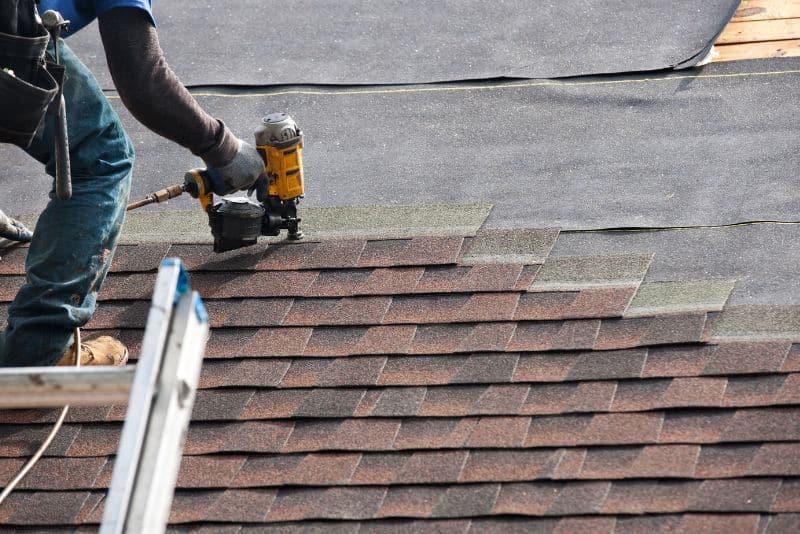We all know that the roof over our heads is more than just a bunch of shingles and nails; it’s the protective shield that keeps us cozy, dry, and safe. But let’s be real—replacing that shield can cost a pretty penny. In fact, the mere thought of it can send shivers down the spine of even the most budget-conscious among us.
But what if I told you that you could replace your roof without emptying your savings account? Yep, you heard that right! Stick around, because we’re going to cover 7 game-changing tips for budgeting for a roof replacement without breaking the bank.

Why Roof Replacement Can Be Expensive
So, before we jump into our life-saving budget tips, let’s get a clear picture of why replacing a roof can make your wallet feel like it’s on a diet. Understanding the costs involved can help you make smarter choices down the line. Here are the main culprits:
1. Labor Costs
Let’s face it, skilled labor isn’t cheap. Roofing is a specialized job that requires expertise, precision, and a whole lot of hard work. From removing the old roof to installing the new one, you’re paying for hours of skilled craftsmanship. And don’t forget about the additional costs for things like scaffolding and safety measures.
2. Material Costs
Quality matters, especially when it comes to something as crucial as your roof. Investing in quality materials not only ensures a longer lifespan for your roof but also adds value to your home. Whether you’re opting for asphalt shingles, metal, or even slate, these materials can be pricey. Plus, you’ll need underlayment, nails, and other accessories that add to the overall cost.
3. Unforeseen Issues
Ah, the dreaded hidden problems! Sometimes, you don’t know what you’re dealing with until the old roof comes off. Rotten wood, damaged insulation, or even pesky critters that have made your attic their home—these are all issues that can inflate your budget faster than a helium balloon.
These are the main reasons why replacing a roof can feel like you’re buying a small island. But don’t worry, in the next section, we’ll tackle how to navigate these costs without sacrificing your financial well-being.

The 7 Budget-Friendly Tips
1. Plan Ahead
Okay, let’s kick things off with the golden rule of any big project: Plan, plan, plan! I can’t stress this enough. Planning ahead can be your best friend when it comes to budgeting for a roof replacement.
Why Early Planning Matters
First off, the earlier you start planning, the more time you have to save money. It’s like putting your savings on a workout regimen—you’ll see better results over time. Plus, early planning allows you to spread out the costs, so you’re not hit with a financial tsunami all at once.
Take Advantage of Sales and Discounts
When you’re not in a rush, you can keep an eye out for sales, discounts, or even bulk purchase deals on roofing materials. Subscribe to newsletters from home improvement stores, follow roofing companies on social media, and heck, even set up Google alerts for roofing material sales.
Assess and Prioritize
Use this time to assess the condition of your current roof. Are there areas that need immediate attention? Or can some repairs wait? Prioritizing helps you allocate your budget more effectively. Consider getting a professional roof inspection to guide your planning.
Create a Budget Cushion
Always, and I mean always, plan for some extra funds as a cushion for those unexpected costs. You know, like when you find out your attic is the winter resort for a family of squirrels. A budget cushion gives you peace of mind and keeps you from going into panic mode.

2. Get Multiple Estimates
Alright, let’s move on to our next money-saving hack: getting multiple estimates. You wouldn’t buy the first car you test drive, right? The same logic applies to your roof replacement. Here’s how to play it smart:
Why Shopping Around is Essential
Think of getting estimates as going on a few dates before settling down. You want to explore your options to find the best match for your needs and budget. Each roofing contractor will have different pricing, warranties, and timelines. By comparing these, you can make an informed decision that won’t leave you with buyer’s remorse.
What to Look for in an Estimate
An estimate should be more than just a number on a piece of paper. It should break down the costs of materials, labor, and any additional fees like permits or disposal charges. Some contractors might offer package deals that include things like gutter cleaning or attic ventilation. Make sure to read the fine print and ask questions!
Don’t Just Go for the Cheapest Option
It’s tempting to just pick the cheapest estimate and call it a day, but remember: you get what you pay for. A low-ball estimate might mean subpar materials or shoddy workmanship. Look for a balance between cost and quality to ensure you’re getting the best bang for your buck.
Get it in Writing
Once you’ve settled on an estimate that fits your budget and needs, get everything in writing. This will serve as your contract and protect you from any surprise charges down the line.

3. Choose the Right Time of Year
Let’s talk timing! Did you know that the time of year you choose to replace your roof can actually save you money? Yep, it’s true!
Seasonal Pricing Fluctuations
Just like holiday airfare or seasonal produce, roofing costs can vary depending on the time of year. Contractors are generally busiest in late spring through early fall, which means higher prices and longer wait times. On the flip side, the off-season could bring you some sweet deals.
Best Times to Schedule
So, when should you pull the trigger? Late winter to early spring can be a golden window. The weather is starting to improve, but contractors aren’t swamped with work yet. Another option is late fall, right before the winter chill sets in. Just make sure to check the weather forecast for any unexpected storms!
The Weather Factor
Keep in mind that certain roofing materials require specific weather conditions for optimal installation. For example, asphalt shingles need warmer temperatures to properly seal. Coordinate with your contractor to pick a time that’s best for the type of roof you’re installing.
Plan Around Your Life
Last but not least, consider your own schedule. Do you have vacations, major life events, or other home improvement projects lined up? Make sure your roof replacement fits seamlessly into your calendar without causing unnecessary stress.
4. Consider Financing Options
Alright, let’s talk about the elephant in the room—financing. Sometimes, even with the best planning, we need a little extra help to cover the costs. And guess what? That’s totally okay! Here’s how to navigate the world of financing without falling into a money pit:
Types of Financing Routes
There are several ways to finance your roof replacement, each with its own pros and cons:
- Personal Loans: Quick and straightforward, but watch out for interest rates.
- Home Equity Loans: These use your home as collateral, offering lower interest rates but putting your home at risk if you can’t repay.
- Credit Cards: Convenient but often come with high interest rates.
- Contractor Financing: Some roofing companies offer financing plans. Make sure to read the terms carefully.
What to Watch Out For
Interest rates are the silent budget-killers. Always compare the APR (Annual Percentage Rate) when considering different financing options. Also, look for any hidden fees or penalties for early repayment.
The Importance of Good Credit
Your credit score plays a big role in the kind of financing you can get. A higher score often means lower interest rates, so it might be worth checking your credit report and improving your score before applying for financing.
Short-term vs. Long-term
Consider how long you’ll be paying off this loan. Short-term loans have higher monthly payments but are usually cheaper in the long run. Long-term loans spread out the cost but can end up being more expensive due to interest.

5. Opt for Durable, Yet Affordable Materials
Let’s talk roofing materials. It’s easy to get overwhelmed with options like asphalt, metal, wood, or even slate. But don’t worry, we’re here to help you find that sweet spot between durability and affordability.
The Pros and Cons of Various Roofing Materials
- Asphalt Shingles: These are the most common and generally the most affordable. They’re easy to install but may not last as long as other materials.
- Metal Roofing: Durable and energy-efficient but can be more expensive upfront.
- Wood Shingles: Aesthetically pleasing and natural, but require more maintenance and can be pricier.
- Slate: Extremely durable but comes with a hefty price tag and requires specialized installation.
Budget-Friendly Options That Don’t Compromise on Quality
If you’re looking for the best bang for your buck, consider architectural asphalt shingles. They offer a great balance of durability and affordability. Another option is corrugated metal roofing, which is less expensive than standing seam metal but still offers good longevity.
Consider the Longevity
Remember, you’re not just paying for materials; you’re investing in the lifespan of your roof. Sometimes spending a bit more upfront can save you money in the long run by reducing the need for repairs or another replacement too soon.
Factor in Energy Efficiency
Some materials, like metal or cool-roof asphalt shingles, can reflect more sunlight and improve your home’s energy efficiency. This can lead to savings on your energy bills, making it a win-win for your budget and the planet!
6. Do Some Work Yourself
Ever thought about rolling up your sleeves and getting a little hands-on with your roof replacement? While I’m not suggesting you climb up there and start hammering away (leave that to the experts!), there are some tasks you can tackle to shave off some costs.
Tasks You Can Safely Do
- Remove Old Shingles: This can be labor-intensive but will save you on labor costs. Just make sure to consult with your contractor first.
- Clean Up: Contractors often include cleanup costs in their estimate. Doing this yourself could save you a bit.
- Paint and Finishing: Once the new roof is on, you can handle the painting and finishing touches.
A Word of Caution
Before you dive into any DIY work, consult with your contractor to make sure it won’t void any warranties or violate any terms of your agreement. Safety first, always!
Tools and Materials
Make sure you have the right tools for the job. Borrowing or renting can be more cost-effective than buying new ones.
The Risk and Limitations
While DIY can save you money, it’s not without risks. Incorrect installation can lead to leaks, damage, and could even void your warranty. Know your limits and don’t hesitate to leave the complicated stuff to the professionals.

7. Use Your Insurance
If you can, use your homeowners’ insurance to help cover the costs. I know, insurance paperwork can be as confusing as assembling a piece of IKEA furniture, but it can really help your budget. Let’s break it down:
When Insurance Comes Into Play
If your roof needs replacing due to factors like storm damage, fire, or vandalism, there’s a good chance your insurance will cover some, if not all, of the costs. However, wear and tear due to age usually isn’t covered.
Navigating the Claim Process
- Document Everything: Take photos and videos of the damage. The more evidence, the better.
- Get an Inspection: Some insurance companies require an inspection by one of their adjusters, but it’s also a good idea to get an independent inspection for your own records.
- File the Claim: Contact your insurance company to start the claim process. Be prepared to provide all the documentation and details.
Understanding Your Policy
Every insurance policy is different. Make sure to read yours carefully to understand what is and isn’t covered. Pay special attention to the deductible and how much the insurance company will reimburse.
The Timeline
Insurance claims can take time, so factor this into your planning. The sooner you file, the sooner you can get approved and schedule your roof replacement.
Replacing your roof doesn’t have to be a financial nightmare. With these 7 budget-friendly tips, you can tackle this home improvement project like the savvy homeowner you are! So go ahead, start planning, get those estimates, and make informed choices.
Additional Resources
To help you on your budget-friendly roof replacement journey, here are some tools and resources that can make the process even smoother:
- Budget Calculators: Websites like RoofingCalc offer free calculators to help you estimate costs.
- Material Cost Comparisons: Check out Consumer Reports for unbiased reviews and comparisons of roofing materials.
- Financing Guides: Websites like NerdWallet offer comprehensive guides on home improvement loans and other financing options.
- Insurance Claim Tips: Insurance Information Institute provides valuable advice on how to file insurance claims for home repairs.
